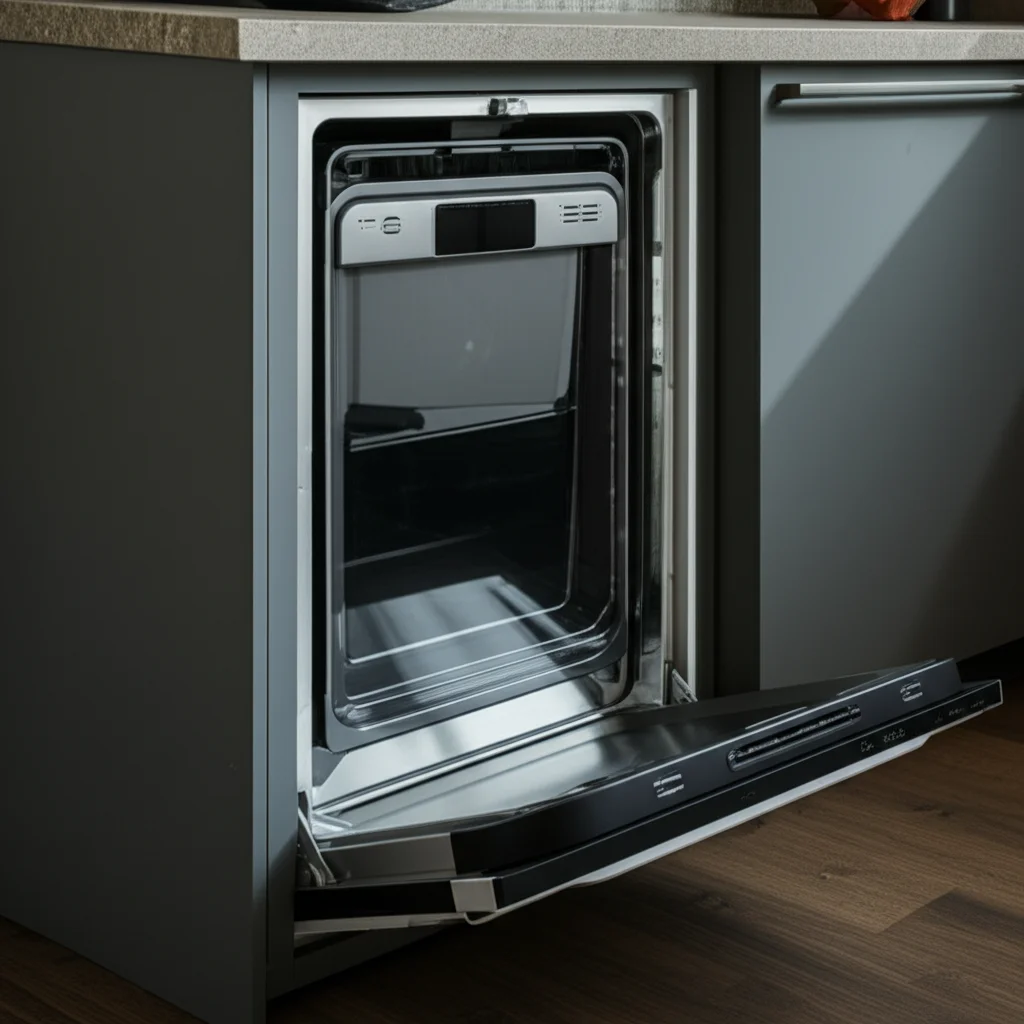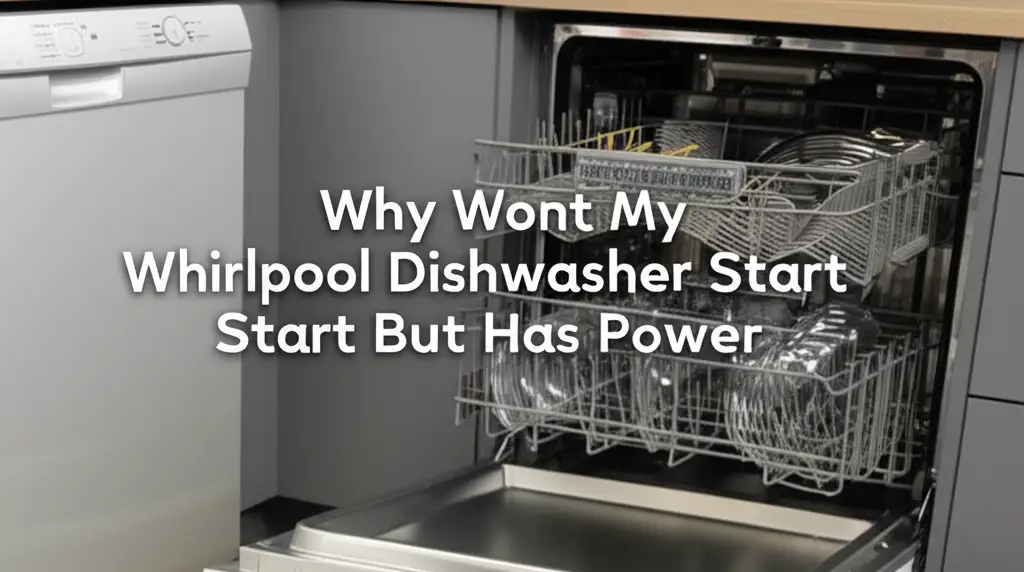· Todd Martin · Appliance Troubleshooting · 23 min read
What Does F1 Mean On A Fisher And Paykel Dishwasher

Understanding the F1 Error on Your Fisher & Paykel Dishwasher
You just loaded your Fisher & Paykel dishwasher, pressed start, and instead of sparkling clean dishes, you see an “F1” error code staring back at you. This can certainly be frustrating. When your appliance displays this particular code, it signals an issue you need to address. Understanding what the F1 error on a Fisher & Paykel dishwasher means is the first step to getting your cleaning cycle back on track.
This error typically points to a water level problem or a flood detection issue. It is the dishwasher’s way of telling you that water has accumulated where it should not be, or that the anti-flood device has activated. I have personally encountered this error, and I know how disruptive it can be. This article will explain the F1 error in detail. It will also guide you through common causes and provide actionable troubleshooting steps. You will learn how to diagnose and potentially fix the problem. This guide aims to help you resolve the F1 error efficiently.
Takeaway:
- The F1 error on a Fisher & Paykel dishwasher signals a flood detection issue or improper water level.
- Check for visible leaks or standing water inside the tub or around the base.
- Inspect the flood sensor, drain hose, and water inlet valve for malfunctions.
- Perform a power reset to clear temporary glitches.
- Clean the dishwasher filter and inspect the drain pump if drainage is suspected.
The F1 error on a Fisher & Paykel dishwasher indicates that the anti-flood device (also known as the flood switch or float switch) has been activated. This activation typically means the dishwasher has detected excess water in the base tray. It is a safety measure to prevent your home from flooding due to a leak or overfill.
Decoding the F1 Error: What It Really Means
When your Fisher & Paykel dishwasher flashes an F1 error, it is giving you a critical safety message. This code points to a problem with water detection within the appliance. Specifically, it usually means the anti-flood device has triggered. This device sits at the bottom of the dishwasher, designed to detect any water escaping the wash tub. It acts as a protective barrier.
The F1 error prevents potential water damage to your kitchen floor or cabinets. It immediately stops the wash cycle and pumps out any detected water. Sometimes, the F1 error can be a false alarm. Other times, it indicates a serious leak or a malfunctioning component. Understanding this distinction helps you know what steps to take next. Do not ignore this error code. Addressing it promptly can save you from bigger problems later on.
Common Reasons for the F1 Error on Fisher & Paykel Dishwashers
An F1 error on your Fisher & Paykel dishwasher can stem from several underlying issues. Each issue relates to water management within the appliance. Identifying the exact cause helps in effective troubleshooting. We will explore the most common culprits.
Malfunctioning Flood Sensor
The flood sensor, also called the float switch, is a key component. It sits at the bottom of your dishwasher’s tub or in the base tray. Its job is to detect if water rises to an abnormal level. If the sensor sticks in the “activated” position, it can trigger an F1 error even if no actual flood exists. Debris or mineral buildup can cause this sticking. A faulty sensor may also give incorrect readings. This component is crucial for preventing overflows.
Water Leaks
One of the most direct causes of an F1 error is an actual water leak. Even a small leak can trip the flood sensor. Water can escape from various points. Common leak sources include damaged hoses, a faulty door seal, or cracks in the dishwasher tub. A persistent drip will eventually accumulate in the base tray. This accumulation then activates the F1 error. Identifying the leak source is crucial. Leaks can cause significant property damage if left unaddressed. If you suspect a leak, you might also consider learning how to repair a leaking dishwasher for a more in-depth guide.
Drain System Issues
Problems with the dishwasher’s drainage system can also lead to an F1 error. If water cannot drain properly, it might back up into the tub. This excess water could then trigger the flood sensor. Common drainage issues include a clogged filter, a blocked drain hose, or a malfunctioning drain pump. Food particles, grease, or other debris can cause these blockages. A partially clogged drain allows some water to pass, but not enough to clear the tub completely. This leads to residual water that can activate the F1 error. Regularly cleaning your dishwasher’s filter is a simple preventative measure. For specific guidance, you can learn how to clean the filter in a dishwasher. You might also find help with how to clean a smelly dishwasher if drainage issues have led to odors.
Water Inlet Valve Problems
The water inlet valve controls the flow of water into your dishwasher. If this valve is faulty, it might allow water to continuously trickle into the dishwasher, even when it is off. This slow, uncontrolled filling can eventually lead to an overfill situation. The flood sensor will then detect this excess water and trigger the F1 error. A stuck-open inlet valve often requires replacement. Checking your water supply is also a good idea. Make sure the water supply valve is fully open and water pressure is adequate.
Excessive Suds
Believe it or not, too much detergent can cause an F1 error. Using too much detergent, or the wrong type of detergent (like dish soap instead of dishwasher detergent), creates excessive suds. These suds can fill the dishwasher tub and spill over into the base tray. The flood sensor interprets this overflow as an actual water leak. It then triggers the F1 error as a safety measure. Always use the recommended amount of dishwasher detergent. Make sure it is specifically designed for dishwashers. If you accidentally used Dawn in your dishwasher, you can find help on what to do if you put Dawn in dishwasher.
Initial Troubleshooting Steps for the F1 Error
When an F1 error appears on your Fisher & Paykel dishwasher, do not panic. Several initial steps can help you diagnose and potentially resolve the issue. These steps are simple and do not require special tools. I always start with these basic checks myself.
Power Reset Your Dishwasher
Often, an error code is just a temporary glitch. A power reset can clear the control board’s memory and resolve minor electronic errors. This is the first thing I try for almost any appliance issue.
- Turn off power: Locate your dishwasher’s circuit breaker in your home’s electrical panel. Flip the breaker switch to the “off” position. If you cannot find the breaker, unplug the dishwasher from its power outlet.
- Wait: Leave the power off for at least 5-10 minutes. This allows the control board to fully discharge any residual electricity.
- Restore power: Turn the circuit breaker back on, or plug the dishwasher back into the outlet.
- Test: Try to start a new cycle. See if the F1 error code has cleared. If it reappears, the issue is more persistent.
Check for Visible Water or Leaks
Before diving deeper, perform a quick visual inspection for any signs of water. This helps confirm if the flood sensor detected actual water or if it is a false alarm.
- Look inside the tub: Open the dishwasher door. Check if there is any standing water at the bottom of the tub. Even a small amount of residual water could be an issue.
- Inspect the base: Carefully pull the dishwasher out from its cabinet a few inches if possible. Look underneath the appliance with a flashlight. Is there any water pooled on the floor? Many Fisher & Paykel models have a removable toe kick panel at the bottom front. Remove this panel to inspect the base tray directly. This is where the flood sensor sits. Water here will trigger the F1 error.
- Examine surrounding areas: Check the floor around the dishwasher. Look for wet spots or water trails. Also, check inside the lower cabinets next to the dishwasher. Any signs of water here indicate a leak.
If you find water, try to identify its source. A small towel can help soak up any standing water in the base. This might temporarily clear the F1 error and allow you to run a diagnostic cycle. However, the underlying leak must be fixed.
Review Recent Use and Detergent Type
Your recent habits can sometimes cause an F1 error. Think about what you did during the last cycle.
- Detergent amount: Did you use more detergent than recommended? Overdosing on detergent can cause excessive suds. These suds can overflow the wash tub and trip the flood sensor.
- Wrong detergent: Did you accidentally use liquid dish soap instead of automatic dishwasher detergent? Regular dish soap creates massive amounts of suds that will definitely cause an F1 error and potentially damage the appliance. If this happened, you need to clear the suds and residue.
- Overloading: Did you overload the dishwasher? Too many dishes can block spray arms or prevent proper drainage, leading to water accumulation.
- Pre-rinsing: Did you pre-rinse dishes excessively? While helpful, too much pre-rinsing can remove necessary food particles for enzyme activation in some detergents, leading to poor cleaning and potentially sudsing issues.
Adjust your detergent usage if you suspect this is the cause. Run a cycle with no dishes and no detergent to flush out excess suds. You can also add a cup of white vinegar to the bottom of the dishwasher and run a short rinse cycle. This helps to break down soap residue. Cleaning the interior regularly, as described in guides like how to clean the inside of a dishwasher, can prevent related issues.
Detailed Checks: Diagnosing the Specific Cause
If a simple power reset or visual inspection does not resolve the F1 error, you need to perform more detailed checks. These steps involve looking at specific components that often cause this error.
Inspecting and Cleaning the Flood Sensor
The flood sensor is a common culprit. If it is stuck or faulty, it will constantly signal a flood.
- Locate the sensor: The flood sensor is typically located in the base pan beneath the dishwasher tub. You usually access it by removing the lower toe kick panel at the front. Some models might require pulling the dishwasher out to access the bottom.
- Check for obstructions: Look for any debris, food particles, or mineral buildup around the float switch. Sometimes, a piece of plastic or a small utensil can get underneath the float and prevent it from returning to its correct position.
- Clean the sensor area: Gently clean around the float and its housing. Use a damp cloth to wipe away any residue. Ensure the float moves freely up and down. If it is visibly damaged or does not move freely after cleaning, it might need replacement.
- Testing (if possible): On some models, you can manually lift the float. You should hear a click as the switch activates. When you release it, it should return smoothly. If it does not click or seems stiff, the sensor may be faulty.
Checking the Water Inlet Valve
The water inlet valve brings water into the dishwasher. A faulty valve can lead to overfilling.
- Locate the valve: The water inlet valve is usually on the bottom left or right side of the dishwasher, behind the access panel. It connects to your home’s water supply line.
- Inspect for leaks: Look for any signs of water dripping or pooling around the valve. A leaky valve can slowly fill the base tray.
- Check for constant flow: With the dishwasher off, listen carefully to the valve. Do you hear a faint trickling sound? If water is constantly flowing into the dishwasher even when it is not running, the valve is likely stuck open and needs replacement.
- Test water supply: Ensure the water supply faucet connected to the dishwasher is fully open. Low water pressure can sometimes confuse sensors, though it is less common for an F1 error.
Examining the Drain System Components
A clogged or faulty drain system prevents water from leaving the tub. This causes water to back up and trigger the flood sensor.
Dishwasher Filter
A clogged filter is one of the most common causes of drainage issues. I always check this first when dealing with water problems.
- Locate the filter: The filter assembly is usually at the bottom of the dishwasher tub, typically under the lower spray arm.
- Remove and clean: Twist or lift the filter components out. Rinse them thoroughly under running water to remove all food particles, grease, and debris. Use a soft brush for stubborn buildup.
- Reinstall: Ensure all filter parts are correctly reassembled and securely locked back into place. A loose filter can also cause problems. For more detailed instructions on cleaning, refer to guides like how to clean your dishwasher DIY.
Drain Hose
The drain hose carries wastewater from the dishwasher to your sink drain or garbage disposal. Blockages or kinks in this hose can impede drainage.
- Inspect for kinks: Pull the dishwasher out slightly. Check the drain hose, usually located at the back, for any visible kinks or bends. Straighten any you find.
- Check for clogs: If the hose runs to a garbage disposal, ensure the knockout plug was removed during installation. Disconnect the drain hose from the garbage disposal or sink drain. Look for any blockages inside the hose or at the connection point. You might need to use a flashlight to see inside.
- Clear blockages: If you find a blockage, use a stiff wire or a specialized drain snake to clear it. Be gentle to avoid damaging the hose. If you want to know more about general drainage issues, check out when dishwasher does not drain.
Drain Pump
The drain pump is responsible for forcing water out of the dishwasher. If it is faulty, water will remain in the tub.
- Listen for sounds: During a drain cycle, listen for the pump’s operation. A humming sound without water moving suggests a blockage or a seized pump. No sound indicates a potential electrical issue or a completely failed pump.
- Inspect for foreign objects: Accessing the drain pump often requires removing the lower spray arm, filter, and sometimes the pump housing cover. Look for small items like glass shards, twist ties, or food debris that could be jamming the impeller. Always disconnect power before attempting this.
- Check connections: Ensure the electrical connections to the pump are secure. If the pump runs but does not drain, the impeller might be broken or worn. You can learn more about general cleaning of this component by reviewing how to clean dishwasher pump.
Addressing Water Leaks: Pinpointing the Source
If you found standing water in the base tray or visible leaks, you need to find the leak’s origin. This is critical to resolving the F1 error permanently. Leaks can sometimes be subtle, so a thorough inspection is important.
Door Seal (Gasket)
The door seal, or gasket, creates a watertight barrier when the dishwasher door is closed. Over time, this seal can wear out, crack, or become brittle.
- Inspect the seal: Run your hand along the entire length of the door gasket. Look for any visible cracks, tears, or signs of deterioration. Check if the seal is properly seated in its channel.
- Clean the seal: Sometimes, food debris or detergent residue can build up on the seal. This prevents it from making a proper seal. Wipe the gasket thoroughly with a damp cloth. You can use a mild soap solution if needed.
- Alignment check: Close the door and check its alignment. A misaligned door can prevent the seal from compressing correctly. Adjusting the door hinges might be necessary if it is crooked.
Internal Hoses and Connections
Inside your dishwasher, several hoses carry water for washing and draining. These hoses can develop cracks or their connections can loosen.
- Access internal components: This usually involves pulling the dishwasher out from its cabinet and removing the outer side panels or the bottom access panel. Refer to your owner’s manual for specific instructions for your Fisher & Paykel model.
- Visually inspect hoses: Look for any visible cracks, punctures, or brittle spots on the hoses. Pay close attention to the connections. Are the clamps tight? Is there any evidence of water marks or mineral deposits around the hose connections?
- Check spray arm connections: Ensure the spray arms are securely attached and not cracked. A loose or damaged spray arm could direct water in unintended ways, leading to leaks.
Tub Cracks or Damage
While less common, cracks in the dishwasher’s main tub can also cause leaks. This is especially true for plastic tubs, but even stainless steel can be damaged.
- Thorough inspection: With the dishwasher empty, use a bright flashlight to inspect the entire inner tub surface. Look for hairline cracks, chips, or holes. Pay attention to corners and around the heating element.
- Test with water: You might fill the tub with a small amount of water (just enough to cover the bottom) and let it sit. Check the base tray after some time to see if any water has seeped through.
- Professional assessment: If you find a tub crack, it often requires professional repair or replacement of the entire tub. This can be a costly repair, sometimes warranting a new dishwasher.
Other Potential Leak Points
- Pump housing: The main wash pump and drain pump assemblies can sometimes leak. Check around these components for water stains.
- Heating element seal: The seal around the heating element at the bottom of the tub can deteriorate.
- Detergent dispenser: A faulty dispenser can sometimes leak, though this usually manifests as water inside the door, not in the base tray.
Addressing any detected leaks is crucial. Even a slow drip will eventually activate the F1 error. For general guidance on managing water-related issues, insights from articles like how to get the dishwasher to drain can be helpful.
When to Call a Professional for F1 Error
While many F1 errors can be resolved with basic troubleshooting, there are situations where calling a professional appliance technician is the best course of action. I know when to wave the white flag and bring in an expert. This ensures safety and often saves money in the long run.
Recurring F1 Error
If you have tried all the troubleshooting steps—power resets, checking for visible leaks, inspecting the flood sensor, and cleaning the drain system—and the F1 error keeps reappearing, it is time for a professional. A persistent error indicates an underlying issue that is not easily fixed by simple adjustments. It might be an intermittent fault with a component, or a subtle leak you cannot detect. A technician has specialized tools and experience to diagnose these complex problems. They can also perform advanced diagnostics on the control board.
Lack of Expertise or Tools
Some diagnostic and repair steps require a certain level of technical skill and specialized tools. For example, replacing a water inlet valve, a drain pump, or repairing a damaged internal hose can be complicated. If you are uncomfortable working with electrical components or plumbing, or if you lack the necessary tools, do not hesitate to call a professional. Attempting a repair beyond your skill level can lead to further damage to the dishwasher or even personal injury. Safety should always be your top priority.
Suspected Major Component Failure
If your troubleshooting points to a failure of a major component, such as the control board, main wash pump, or a significant leak from the tub, a professional is highly recommended. These parts are expensive, and their replacement is intricate. An incorrect installation can lead to more problems. A technician can confirm the component failure and replace it correctly. They also often carry common replacement parts, speeding up the repair process. They can also advise if the cost of repair outweighs the cost of replacing the entire appliance.
No Visible Water, But F1 Persists
Sometimes, the F1 error appears, but you cannot find any visible water in the base tray or around the dishwasher. This scenario often suggests a faulty flood sensor that is constantly triggered, or an issue with the control board misinterpreting signals. These are harder to diagnose without professional equipment. A technician can test the sensor’s continuity and signal output. They can also check the control board for faults.
Warranty Considerations
If your Fisher & Paykel dishwasher is still under warranty, attempting complex repairs yourself might void the warranty. Check your warranty documentation before proceeding with any significant DIY repairs. In such cases, contacting Fisher & Paykel customer service or an authorized service center is the best approach. They can guide you through the repair process under warranty terms.
Preventing Future F1 Errors: Maintenance Tips
Preventing problems is always better than fixing them. Regular maintenance can significantly reduce the chances of your Fisher & Paykel dishwasher displaying an F1 error. I find a consistent maintenance routine saves me a lot of hassle.
Regular Filter Cleaning
The dishwasher filter is a primary line of defense against drainage issues. Food particles, grease, and debris accumulate here.
- Frequency: Clean your dishwasher filter at least once a month, or more often if you use the dishwasher frequently or wash heavily soiled dishes.
- Procedure: Remove the filter assembly (usually a cylindrical and flat screen combination) from the bottom of the tub. Rinse both parts thoroughly under running water. Use a soft brush to scrub away stubborn residue. Reinstall correctly. This simple step prevents blockages that can lead to water backup and sensor activation. For a full guide, check out how to clean filter in dishwasher.
Proper Detergent Use
Using the correct type and amount of detergent is crucial for optimal performance and preventing sudsing issues.
- Type: Always use automatic dishwasher detergent. Never use liquid dish soap. Dish soap creates excessive suds that will overflow and activate the flood sensor.
- Amount: Follow the detergent manufacturer’s recommendations. More detergent does not mean cleaner dishes; it often means more problems. Adjust the amount based on your water hardness and soil level. If you have hard water, consider using a rinse aid to improve drying and prevent spotting.
- Storage: Store detergent in a cool, dry place. Old or clumpy detergent can dissolve poorly and cause issues.
Inspecting Hoses and Seals
Periodically check the external and internal components for signs of wear or damage.
- Drain hose: Every few months, pull the dishwasher out slightly. Inspect the drain hose for kinks, cracks, or blockages. Ensure it has a proper high loop if connected to a garbage disposal.
- Water supply hose: Check the water inlet hose for leaks or deterioration. Make sure its connections are tight.
- Door gasket: Wipe down the door seal regularly with a damp cloth to remove food debris and mildew. Inspect it for cracks or tears that could lead to leaks. A well-maintained gasket ensures a tight seal during cycles.
Running Cleaning Cycles
Even if your dishwasher looks clean, internal components can accumulate mineral deposits and grease.
- Vinegar wash: Place a cup of white vinegar in a dishwasher-safe bowl on the top rack. Run a hot cycle with an empty dishwasher. Vinegar helps break down hard water deposits and soap scum.
- Baking soda wash: Sprinkle a cup of baking soda on the bottom of the empty dishwasher. Run a short hot cycle. Baking soda helps deodorize and clean.
- Commercial cleaners: Use a specialized dishwasher cleaner every few months. These cleaners are designed to remove stubborn buildup from spray arms, pumps, and hoses. You can also explore methods for how to clean dishwasher with vinegar or how to clean dishwasher with baking soda.
Avoid Overloading
Overloading your dishwasher can impede water circulation and drainage. This can lead to inefficient cleaning and potential water issues.
- Proper loading: Do not block spray arms. Ensure water can reach all dish surfaces. Leave space between items. This promotes effective washing and draining. Proper loading prevents water from splashing outside the tub or accumulating due to poor drainage.
By following these simple maintenance tips, you can extend the life of your Fisher & Paykel dishwasher. You will also significantly reduce the likelihood of encountering the frustrating F1 error. A well-maintained appliance performs better and lasts longer.
Frequently Asked Questions About Fisher & Paykel Dishwasher Errors
Can I reset the F1 error code on my Fisher & Paykel dishwasher?
Yes, you can often clear the F1 error by performing a power reset. Turn off the dishwasher at the circuit breaker for 5-10 minutes, then restore power. This can clear temporary electronic glitches. If the underlying issue persists, the error will reappear.
Is the F1 error always a sign of a leak?
Not always. While an F1 error commonly indicates a water leak or overfill, it can also be triggered by a faulty flood sensor, excessive suds from too much detergent, or a simple electronic malfunction. Always check for visible water first.
How do I locate the flood sensor in my Fisher & Paykel dishwasher?
The flood sensor (float switch) is typically located in the base pan beneath the dishwasher’s main tub. You usually access it by removing the lower toe kick panel at the front of the appliance. Refer to your owner’s manual for its exact location and access method.
What should I do if my dishwasher has standing water and an F1 error?
First, disconnect power to the dishwasher. Then, remove any standing water from the tub and the base tray. Carefully inspect for leaks from hoses, door seals, or the tub itself. Clean the filter and check the drain hose for clogs.
How often should I clean my dishwasher to prevent error codes?
Regular maintenance is key. Clean your dishwasher’s filter at least once a month. Run a self-cleaning cycle with vinegar or baking soda every 1-3 months to prevent mineral buildup and odors. Inspect hoses and seals annually. Consistent cleaning reduces the chance of issues.
Can using too much soap cause an F1 error?
Yes, using too much detergent or the wrong type (like hand dish soap) can cause excessive suds. These suds can overflow the wash tub into the base tray, activating the flood sensor and triggering the F1 error. Always use the recommended amount of automatic dishwasher detergent.
Conclusion
Encountering an F1 error on your Fisher & Paykel dishwasher can be a temporary setback, but it is a clear signal from your appliance. This error code primarily indicates an issue with water detection, often pointing to a potential flood or an activated anti-flood device. While it can be alarming, many common causes, from a simple clogged filter to an overactive flood sensor, are fixable with straightforward troubleshooting steps. My own experiences have shown me that patience and a methodical approach yield the best results.
We have walked through understanding the F1 error, exploring its common culprits like leaks, drainage problems, and faulty sensors. We also covered practical steps for initial troubleshooting and detailed inspections. Remember to always prioritize safety by disconnecting power before performing any internal checks. By following these guidelines and maintaining your dishwasher regularly, you can often resolve the F1 error yourself. If the problem persists or involves complex component failures, do not hesitate to contact a qualified technician. Taking proactive steps ensures your Fisher & Paykel dishwasher continues to deliver sparkling clean dishes for years to come.





